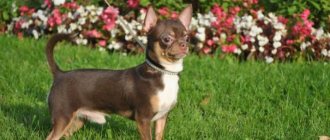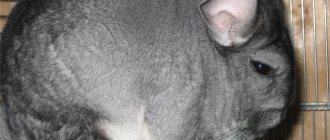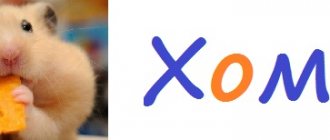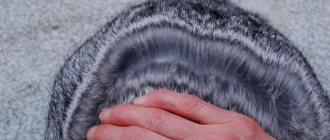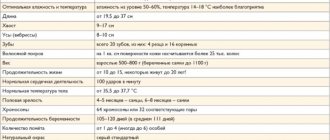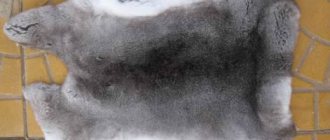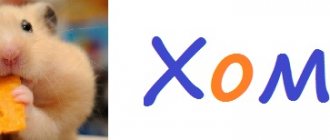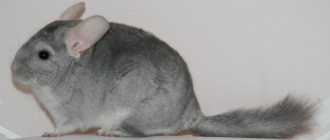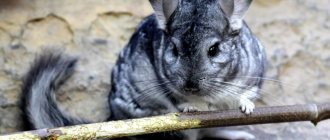- home
- Chinchilla
- Character and features
04/04/2019 The chinchilla is a beautiful and incredibly cute animal that has become popular for home breeding. The most important indicators of health and proper development are the size and weight of the chinchilla. Zoologists have determined the average parameters of the animal, which can be used as a guide during different periods of its life.
Adult chinchilla size
At the same age, chinchilla sizes may vary depending on:
- gender;
- genetic characteristics;
- health conditions;
- living conditions.
An animal kept in pairs is larger in size than one raised alone.
The size of an adult female specimen exceeds that of a male. For different specimens, the body length ranges from 22 to 38 cm, the tail grows from 8-10 to 15-17 cm.
Signs of old age
Senile changes in chinchillas are divided into 2 stages:
- presenile;
- senile.
By the age of 12, chinchillas show signs of old age. The speed of the animal’s movements decreases, hearing and smell deteriorate, and reproductive function fades.
The appearance of the furry pet also changes:
- the surface of the teeth is worn off;
- the coat thins and loses its gloss;
- pigment spots appear on the ears;
- the eyes stop shining.
In old age, atrophy of the skin and muscles is observed, and tumors often appear. Hypofunction of internal organs, slowing down of metabolic processes and weakening of adaptation are observed. In old age, a pet especially needs a healthy diet and special attention from its owners.
Important! If the most comfortable conditions are provided, a chinchilla can live at home for up to 25 years.
Chinchilla weight
An adult female weighs on average 500-650 grams, but can reach 800. There are known cases when a female had a kilogram mass. Males are smaller in size and weight than females. Their average weight is from 450 to 600 grams. Even large individuals usually do not exceed 700 grams.
Owners of pets whose size and weight deviate from the average in one direction or another should especially carefully monitor the well-being of the animal. If he has a good appetite and is at the same time mobile and active, then there is nothing to worry about.
If, after mating, an adult female chinchilla suddenly gains weight, this may be a sign of pregnancy. After mating, it is recommended to weigh the animal regularly. This will help you notice deviations in the condition of the female and her offspring in time and take the necessary measures.
If in infancy and childhood rodents gain weight evenly, this means that they receive in sufficient quantities everything they need for development. Starting from one and a half years, any weight fluctuations should be alarming. In the absence of pregnancy, the reasons may be either illness or non-compliance with the conditions of keeping the mammal.
Weighing equipment
There is no need to weigh your chinchilla using expensive scales. Many exotic rodent owners go to their local department store and find a perfect scale in the kitchen section.
Chinchilla on the scales
The scale should be able to switch from ounces to grams. Grams are used when weighing chinchillas because they are smaller. This helps show the change much sooner than a much larger ounce measurement would. If the scale doesn't have a container to put your chinchilla in, a small bowl, box, or cage can be used. A small notepad should be used to record the chinchilla's weight and the date of measurement.
Weight of cubs from birth to month
Unlike other rodents, chinchilla puppies are born with fur, teeth and sight. Already at the age of a week they are able to feed on their own.
Newly born babies look like fluffy balls weighing only 30-50 grams. The initial parameters of the animals are influenced by:
- parents' sizes;
- number of puppies in the litter;
- the course of pregnancy in a female.
There are newborns weighing up to 70 grams. But it is not at all necessary that such a cub will become a very large individual.
However, when purchasing a chinchilla, ask about its parameters at birth, as well as what type of puppy it was born with. As a rule, the first puppies in a litter are larger than the last. In the future, these data will help assess the baby’s development.
The lactation period in chinchillas lasts from 45 to 60 days. On the first day, the cubs can lose up to 2 grams of weight. From the second day they have been gaining it steadily. Chinchillas grow quite quickly. After a month, the animals are almost three times heavier than on the first day.
Table of body weight gain in the first month of life for puppies
| Age (days) | Weight (grams) | Age (days) | Weight (grams) | Age (days) | Weight (grams) |
| 1 | 30-50 | 11 | 50-75 | 21 | 76-104 |
| 2 | 31-52 | 12 | 52-77 | 22 | 78-107 |
| 3 | 33-54 | 13 | 55-80 | 23 | 80-110 |
| 4 | 35-56 | 14 | 58-83 | 24 | 83-113 |
| 5 | 36-59 | 15 | 61-86 | 25 | 87-117 |
| 6 | 38-61 | 16 | 63-89 | 26 | 90-121 |
| 7 | 40-63 | 17 | 66-92 | 27 | 93-125 |
| 8 | 42-66 | 18 | 68-95 | 28 | 96-129 |
| 9 | 45-69 | 19 | 71-98 | 29 | 100-133 |
| 10 | 47-72 | 20 | 73-101 | 30 | 103-137 |
The daily increase in the first week does not exceed one and a half grams. It increases noticeably during the second week and amounts to 2-3 grams per day. And from the 24th day of life, babies gain 3-4 grams daily. If the puppies are gaining weight well, it means they have enough milk. If this indicator is significantly lower than normal and upon examination of the female it turns out that she has no milk, the babies are placed with a wet nurse. If this is not possible, they are fed artificially. In this case, during the first week, the cubs are given a special mixture at least every 2.5-3 hours.
By comparing the size and weight of a chinchilla by month with the average parameters, you can understand whether it is developing correctly.
Zoologists suggest focusing on average data. A chinchilla should weigh:
- at the end of the first month about or slightly more than 113 grams,
- at the end of the second - 242,
- at the end of the third - 327,
- fourth - 385 grams,
- sixth - 475,
- at the end of the eighth - 506 grams.
By ten months, the animal reaches a weight of approximately 600 g. By one year, chinchillas usually have the size of an adult animal. But some individuals still continue to grow up to one and a half years. Uniform development of the animal is rare, but with proper care the final indicators will be close to normal.
How big are the puppies?
Their weight range is from 25 to 60 grams. This criterion depends on the nutrition of the mother who feeds them with her milk, the conditions in which newborns are kept and the genetic characteristics of the female. A larger female gives birth to larger offspring. If, for example, mother and daughter have the same color, then with a high degree of probability we can expect that the daughter will grow up to be large.
Mature puppies need a lot of fiber to grow and achieve a normal weight; their diet should consist mainly of grass hay and food with a high protein content (25%).
Why does a chinchilla lose weight?
Weight fluctuations in a rodent may indicate health problems or errors in maintenance.
Newborns must be weighed, so it is easy to identify the lack of milk in the mother. If the weight of the entire litter is below normal, it is necessary to supplement the pets artificially. It is better to weigh on a scale with at least 1 gram division. It is enough to do this once every 5-7 days to track the dynamics of indicators.
Adult animals also need to be placed on scales regularly. If weight loss is noticed, the cause may be illness or stress. In this case, weigh your pet every day. If it turns out that he is losing 10 g daily, this will confirm the seriousness of the problem.
Here are several reasons for chinchilla weight loss:
- possible presence of parasites;
- excess physical activity. You can temporarily remove the running wheel from the cage and watch your pet;
- low calorie diet. Try to adjust it;
- complete refusal to eat. In this case, you need to check your teeth.
How to achieve uniform development and growth of your pet?
Chinchillas are herbivores that are quite fastidious about changing their diet. They are quite active and playful, so their diet should be enriched with proteins and carbohydrates. Rodents do not finish old food, and if they don’t like something, the rodent will remain hungry, but will not eat what they don’t like.
List of prohibited products:
1. Pine nuts grains, fried seeds. This food will worsen your digestion. 2. Any prepared food; the chinchilla eats exclusively raw foods. 3. Flour products of any kind. The rodent only approves of crackers made from wheat flour. 4. Chinchilla does not digest rye. 5. Products that have no nutritional value. 6. Monotonous diet. 7. Food from the hosts' table.
If you introduce grains into your diet, they should be of exceptionally high quality. Sometimes you can pamper your beloved pet with dried fruits, rose hips, hawthorn, fresh vegetables and fruits. Chinchillas love apples, carrots, bananas, melon, potatoes, and cabbage. The main part of the diet is hay and slightly dried greens. An abundance of carbohydrates will lead to obesity, so feeding the animal is prohibited.
Living conditions in the wild
These animals live in harsh, cold conditions in the highlands. Therefore, they have very dense and thick fur. Among the different types of fur-bearing animals, chinchilla fur is the densest. This is very convenient for the animal in the sense that such fur does not contain parasites. But this fur cannot tolerate moisture - it quickly gets wet. So chinchillas like to swim not in water, but in sand.
These rodents in nature are divided into two types: long-tailed and short-tailed. Long-tailed chinchilla fur is considered more expensive than short-tailed chinchilla fur. Therefore, there are very few long-tailed chinchillas left, they are found only in certain regions of the high Andes, for example, in northern Chile. There are slightly more short-tailed animals preserved in nature. But, nevertheless, both species are listed in the Red Book.
Due to the high demand for fur, rodents were hunted extensively and successfully. Therefore, their numbers in their homeland, in the mountains of South America, have dropped significantly and their distribution area has also greatly decreased. Now these animals have begun to be protected in those places where they still live in the wild. But there are still much fewer of them now than there once were.
How to extend the life of a pet?
In order for an animal to live to a ripe old age, a rich life, it needs proper care. Chinchillas are no exception.
They need to create the right “habitat” in the apartment. That is, the place where they will live must be comfortable and fully meet their requirements in life. The cage for the animal should be spacious. The minimum area is 0.5 square meters.
The following devices must be installed in the cage:
- a house in which the animal will hide;
- wooden shelves for teeth points;
- hanging drinking bowl;
- feeder, can be either wall-mounted or floor-mounted;
- mineral and salt stones for sharpening teeth - they can also be a source of minerals and vitamins for animals;
- fill the floor with special wood filler;
- hanging canopy.
The video below clearly shows what should be in a chinchilla's cage, and why all this is needed.
It is also important to monitor the temperature of the room in which the chinchilla’s cage is located. In nature, they are accustomed to cool mountain air
At home, you need to get closer to a similar temperature. Although up to 25 degrees Celsius is considered a suitable temperature, the ideal room temperature will still be about 17 degrees above zero. This temperature is more similar to the highlands of South Africa.
In the wild, chinchillas are accustomed to making their own sand baths. This is how they take care of their hygiene and, accordingly, their health. You cannot deprive them of this procedure at home. Bathing in the sand should be regular and even daily. To do this, you can put a container with sand in the animal’s cage, deep enough so that it can bathe on its own whenever it wants.
Nutrition plays one of the most important roles in the process of healing and increasing the longevity of chinchillas.
There is a list of foods that should be avoided in a rodent's diet.
- Sweet foods, such as grapes. Chinchillas' bodies do not produce insulin, which means they will not be able to cope with blood sugar.
- Fatty nuts have a negative effect on the liver of animals, and this also includes sunflower seeds.
- The stone fruit tree, its branches and fruits contain hydrocyanic acid, which is poisonous to rodents.
- Coniferous tree branches.
- Toxic substances that may be contained in paper products (such as newspapers and wallpaper). They poison the body and lead to diseases of the animal’s gastrointestinal tract.
